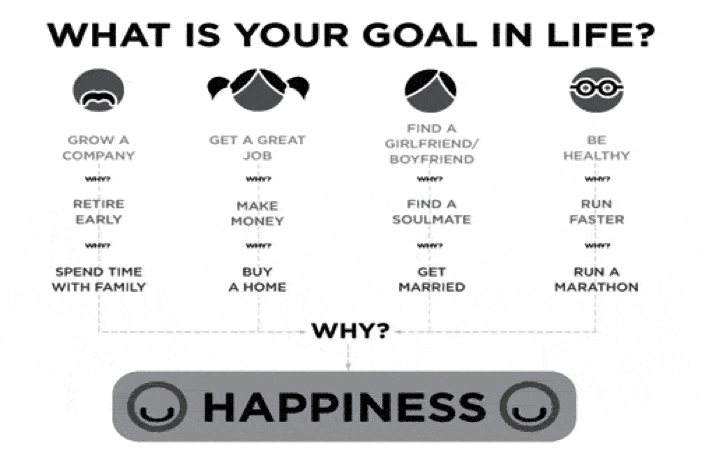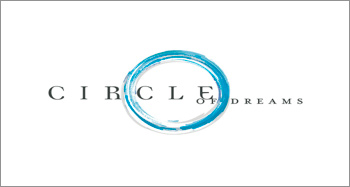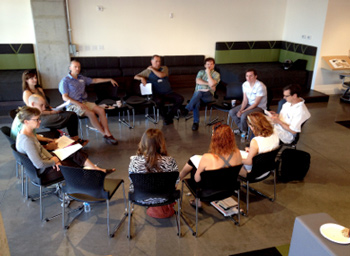When I was 5 years old my mother always told me that happiness was the key to life. When I went to school they asked me what I wanted to be when I grew up. I wrote down ‘happy’. They told me I didn’t understand the assignment, and I told them they didn’t understand life.
– John Lennon
Zappos CEO, Tony Hsieh, enjoys asking people to share their goals. For sake of interaction, I’d like you to think of one of your own. Does everybody have one? It could be to grow a company. Discover a great job. Find someone to share your life with.
Now ask yourself, “why?” Maybe it’s to retire early, make good money, or find a soul mate.
Now ask yourself, “why?” again. To spend time with family, buy a home, get married.
But “why?”
If you do that exercise long enough, as varied as our initial goals may have been, we all arrive at a common denominator: We think whatever we’ve chosen will make us happy!

If happiness is what we are all after then doesn’t it make sense to learn as much about it as we can?
A portion of our happiness – perhaps 50 percent – is simply genetic. But every day we learn more about the environmental and social conditions that impact the remaining share. Having a rich social network, engaging in satisfying work, and feeling a sense of gratitude are among the things we know contribute to happiness. What doesn’t seem to matter much is making excessive amounts of money or getting lots of education.
Interesting Fact – Panama may be the happiest country in the world, racking up the highest score in the Gallup-Healthways Global Well-Being Index for 2013.
In contrast, conflict-afflicted countries such as Syria and Afghanistan showed the lowest scores in this survey of 135 countries. The United States came in at number 14 in the poll.
The Global Well-Being Index aims to gauge people's perceptions of their well-being, by looking at financial status as well as four other factors that contribute to well-being: social well-being, which means having supportive relationships and love in life; community well-being, which is about liking one's place of residence; having purpose and goals; and physical health.
Only 1 in 6 adults (17 percent) worldwide were considered to be "thriving" in at least three of these five elements of well-being. The majority of global populations were "struggling" or "suffering" in many of these domains, the researchers found.
Here are the 10 happiest countries, with the percentage of people who are "thriving" in three or more of the elements of well-being:
• Panama: 61%
• Costa Rica: 44%
• Denmark: 40%
• Austria: 39%
• Brazil: 39%
• El Salvador: 37%
• Uruguay: 37%
• Sweden: 36%
• Canada: 34%
• Guatemala: 34%
The 10 lowest-ranked countries:
• Syria: 1%
• Afghanistan: 1%
• Haiti: 3%
• Democratic Republic of Congo: 5%
• Chad: 5%
• Madagascar: 6%
• Uganda: 6%
• Benin: 6%
• Croatia: 7%
• Georgia: 7%

What Makes Us Happy – The Science of Happiness QUIZ
Click here

Write a brief biography about yourself, and then read instructions below.
(Minimum Length: One Page) Deposit on ICONAfter you have completed your biography, look at the words you used. Does the language express positive emotions or are they more deadpan? In a study of nuns, those who at age twenty included positive-emotion words in their biographies lived about a decade longer than their more deadpan peers.
(Short Answer) Deposit on ICON
But Will It Make You Happy?
Read here

The Secrets of Happiness
Read here

My interview with Chris Peterson
Listen here
Nate Staniforth Biography – Nate Staniforth began touring while still a student the University of Iowa, studying theater, history, and religion by day and driving for hours to perform on other campuses at night. Nate’s 2007 web series The Magician Project caught the eye of superstar David Blaine who recruited Nate to design an original illusion for Blaine to use on his national ABC television special. In 2009 Nate traveled extensively through India and Southeast Asia to explore the magic in these cultures as part of a documentary about magic around the world, meeting with psychics, snake charmers, street performers, shaman, and anyone who could show him something amazing. Nate now tours the country full time, bringing his unique “unplugged” style of magic to over a hundred colleges, universities, and theaters every year.

My profile on Nate Staniforth – Magic
Watch here

After watching the profile piece, what questions would you like to ask Nate Staniforth? Please submit three possibilities, and Nate will respond to the ten best questions from the class. Nate’s answers will be forwarded to everyone.

Here you'll find some of my musings that I think will help support the narrative, and provide some additional information. Check it out here


“Circle of Dreams” – An Experiment in Generosity
I have always been drawn to dreamers. They are the ones who see life not for what it is, but what it can be, and then fearlessly fight to make it so. While all dreamers have their own chorus of cynics, artists may have the toughest lot. In a world so closely aligned with profit, their dreams often seem particularly risky and out of step. After all, how can one put metrics on “magic?”
Artists recognize these obstacles, but can’t help themselves. Creating is simply in their DNA. And so they soldier on, clinging to ideals that only they can fully see, in search of someone with the faith to help. The journey is far too often lonely and frustrating. But the good news is that it doesn’t have to be that way.
On July 1, 2014, I assembled a small group of Las Vegas’ most talented visual and performing artists in what’s being dubbed the “Circle of Dreams.” (E.g. Le Reve, Mystere, UNLV Department of Film, Smith Center, Blue Man Group) Each participant was required to identify one dream of his/her own to place into “the circle,” along with a willingness to apply their contacts, experience, resources, and affirmation to the dreams of others.

Wharton professor, Adam Grant, writes that few of us act purely as givers or takers, instead matching an equal balance of giving and getting. For this experiment to succeed, however, generosity must rule the day. The Circle of Dreams is based on the premise that when one’s attention and energy is focused on making a meaningful difference in the lives of others, personal success just might follow as a by-product.
Two weeks later, the group reconvened to “open” – as in a gift - the ideas gathered to move each dream forward. What can generosity produce? The answer: Twenty-four pages of new ideas. The suggestions ranged from important contacts, to new venues. Some even included phone numbers, with a promise that the person would be expecting their call. The most stirring gifts to me, however, were the intimate gestures. These came in the form of promises to build websites, construct Kickstarter campaigns, and hit the pavement in search of potential audiences. One member of the group even donated her home so that another artist in the “circle” might have a venue to perform.
The word “community” gets batted around quite a bit these days. It has come to mean little more than living in close proximity to one another. I suggest we not only reclaim the word, but also demand it is associated with the depth individuals are willing to commit to one another.

Think of something special you could do for someone, and without letting anyone (but me) know – do it! What did you do, and how did it make you feel? What was the person’s reaction?
(Minimum length: One Page.) Deposit on ICON (Inspiration: Conversation with Christopher Peterson)